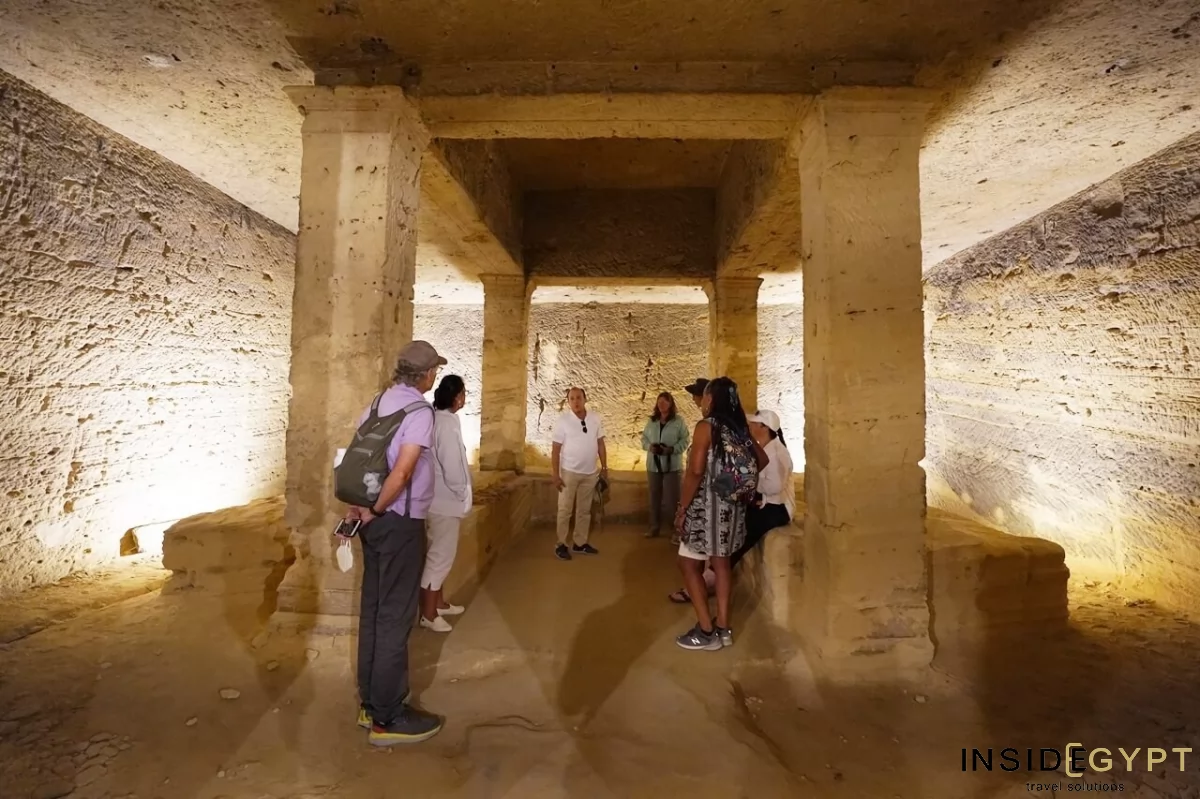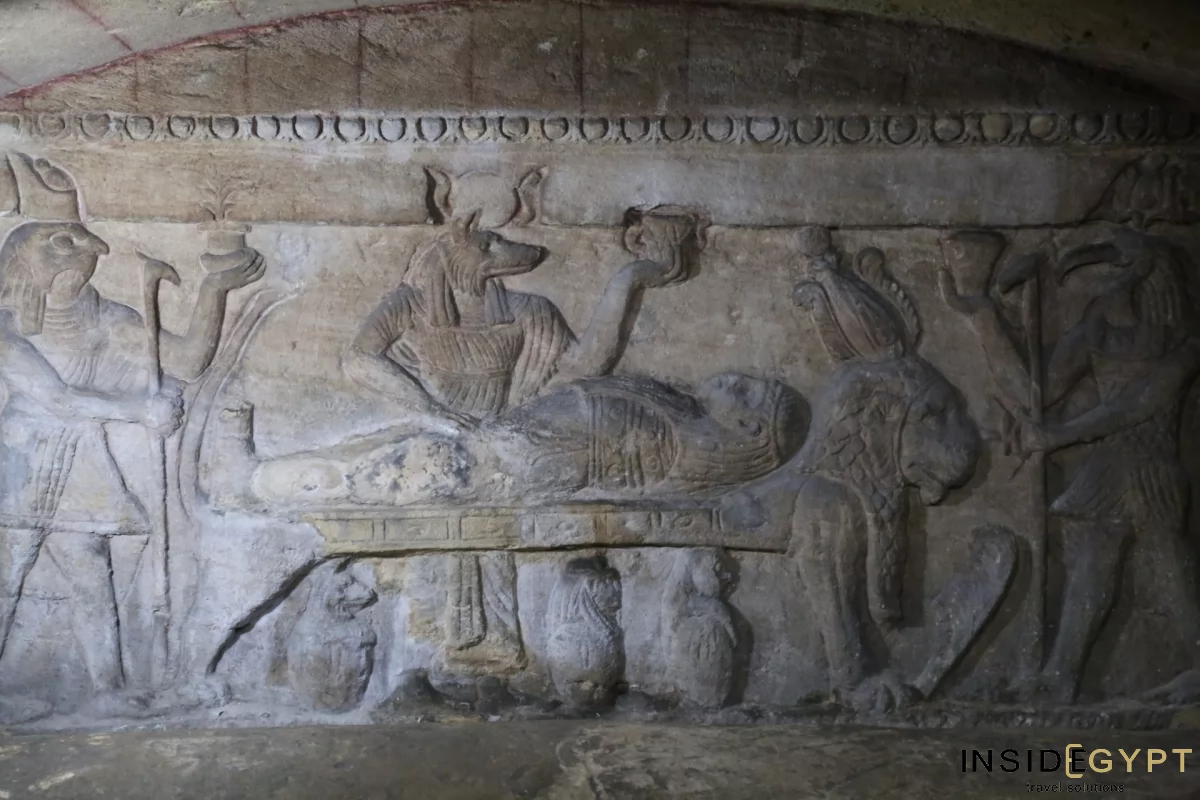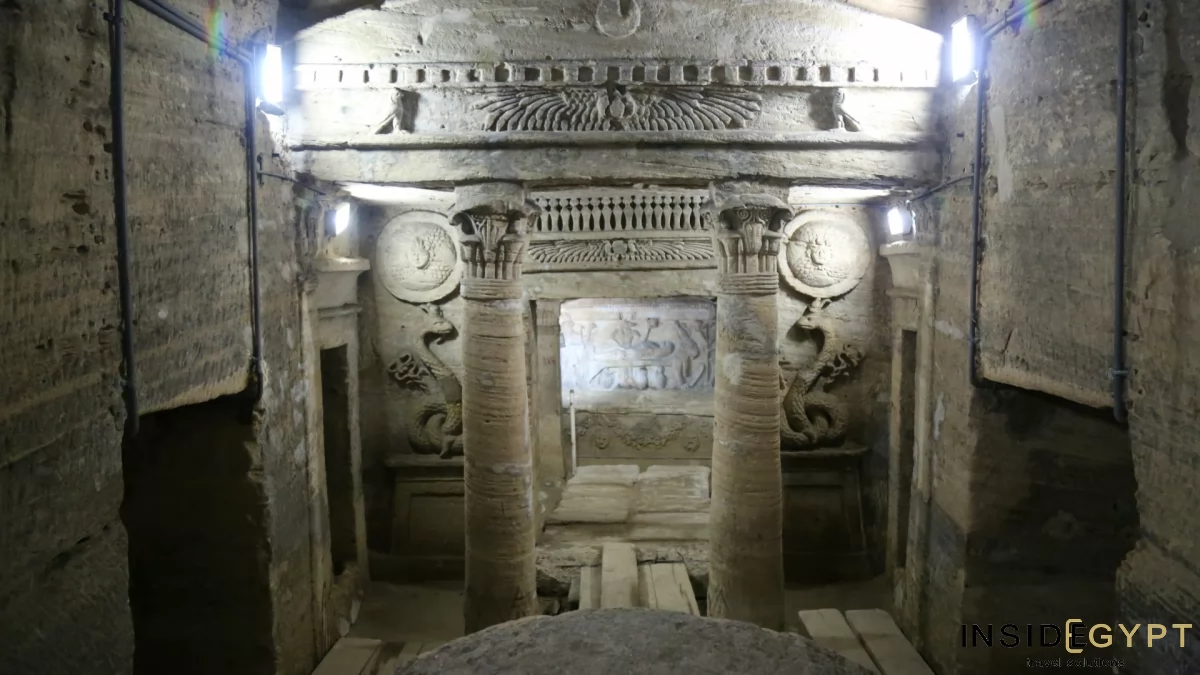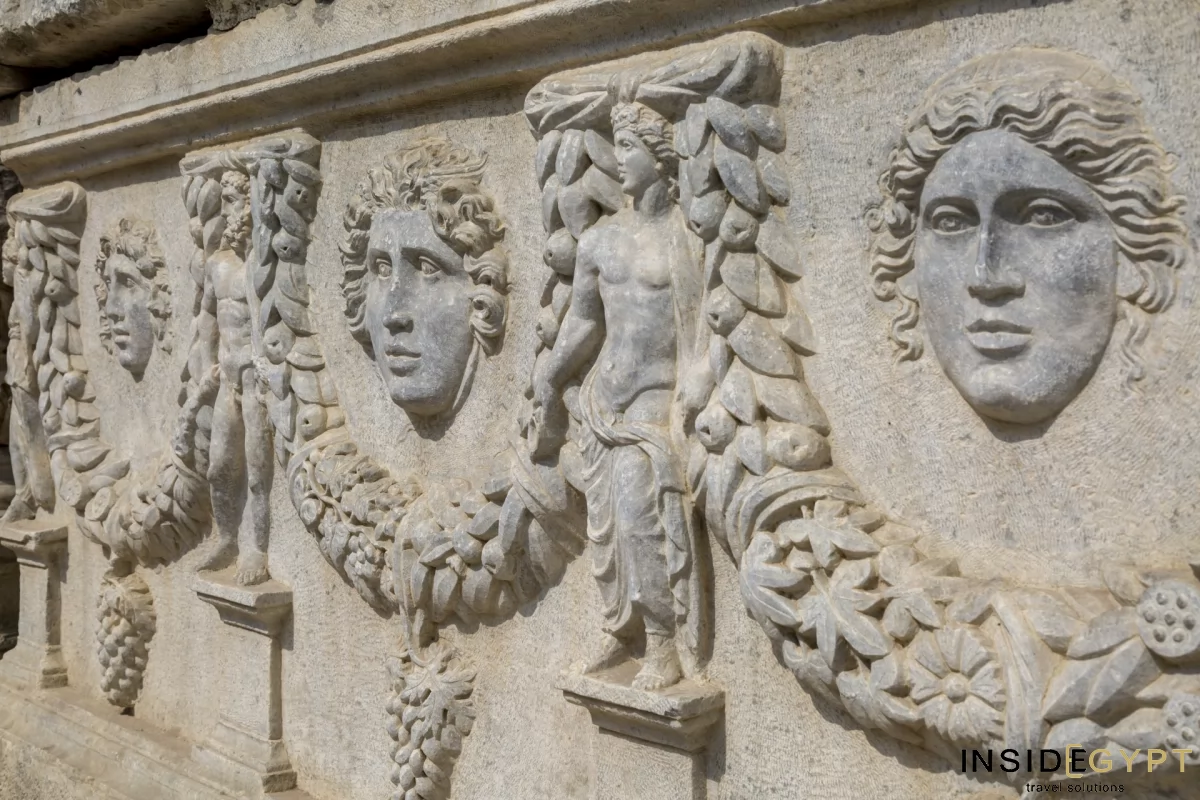Stay updated!
The Catacombs of Kom El Shoqafa are one of Alexandria's most fascinating historical sites, renowned for the remarkable blend of ancient Egyptian, Greek, and Roman architectural styles. This unique burial site, dating back to the 2nd century CE, showcases the diverse cultural influences that shaped Alexandria. As you explore the intricate carvings and expansive hallways, you'll discover how this extraordinary site reflects the confluence of different civilizations that once thrived in this ancient city.
Recognized as one of the Wonders of the Middle Ages, the Catacombs of Kom El Shoqafa Alexandria exemplify the ingenuity and artistry of the time. These Egyptian catacombs served not only as burial places but also as a testament to the rich history and spiritual beliefs of the people. As you wander through the subterranean chambers, you will encounter stunning tombs, sarcophagi, and sculptures that tell stories of the past, making a visit here truly unforgettable.
To fully appreciate the significance of the Catacombs of Alexandria, consider joining our exclusive 15 Day Egypt Tour with Siwa Oasis. Our expert guides bring the history of this extraordinary site to life, illuminating the stories behind the art and architecture. This tour provides an engaging and educational experience, ensuring that visitors leave with a deep understanding of this important historical landmark.
Inside Egypt offers a convenient 1-day add-on to Alexandria to many its packages, which includes a visit to the Catacombs of Kom El Shoqafa. This extension to your all-inclusive package allows you to delve into the captivating history of Alexandria, making the journey even more enriching and memorable. Discover the wonders of this ancient city and the secrets held within its renowned catacombs on your next adventure!
Experience Egypt in an unrivaled way that brings you closer to its history and culture. Learn more about our luxury Egypt tours!
Photos of Alexandria’s Catacombs










Discover Our Exclusive Egypt Tours
Tour Reviews
FAQ About the Catacombs of Kom El Shoqfa
What are the Kom El Shoqafa Catacombs?
The Catacombs of Kom El Shoqafa are a remarkable multi-level subterranean burial site located in Alexandria, Egypt. These ancient catacombs serve as an exceptional example of the fusion of Egyptian, Greek, and Roman traditions, showcasing the cultural and artistic influences that characterized Alexandria during the Roman period. The site features intricate carvings, tombs, and chambers that reveal the unique blend of these civilizations' beliefs and practices surrounding death and the afterlife.
Historically, the catacombs in Alexandria reflect the city's cosmopolitan heritage, where various cultures coexisted and interacted. The architectural design of the Kom El Shoqafa highlights this blend, with features that include classical Roman pillars, Egyptian reliefs, and Greek inscriptions. This diversity not only underscores Alexandria's significance as a center of trade and learning but also illustrates how different cultural influences can shape artistic expression and religious practices.
The cultural importance of the Alexandria catacombs extends beyond their architectural beauty. They provide valuable insights into the funerary customs of the time, including rituals and beliefs prevalent among the local population and immigrants alike. As a burial site, the Catacombs of Kom El Shoqafa offer a tangible connection to the past, revealing how the inhabitants of Alexandria navigated their identities amidst a diverse cultural landscape.
Visiting these catacombs in Egypt serves as an enriching experience for those interested in history, art, and archaeology. For anyone exploring Alexandria, the Kom El Shoqafa Catacombs stand as a symbol of the city's rich heritage and historical legacy. Truly these are a must-see attraction for visitors wanting to understand the depth of Alexandria's diverse cultural narrative.
How deep are the Catacombs of Alexandria?
The Catacombs of Alexandria descend approximately 35 meters (115 feet) below ground, revealing a fascinating and intricate layout that spans multiple levels. The entrance to the catacombs is an inviting opening that leads visitors into a world of ancient history and artistry. As you venture further inside, you will encounter a complex system of corridors, chambers, and burial sites that reflect the rich cultural tapestry of Alexandria.
One of the significant features of the catacombs is the main burial chamber, which houses several death tomb catacombs, adorned with detailed carvings and inscriptions. This chamber showcases the distinct architectural styles of the various cultures that influenced the area, including the use of loculi, which are wall niches used to entomb the deceased. The careful arrangement and decoration of these loculi demonstrate the importance of burial practices in honoring loved ones and preserving their memory.
In addition to the burial chambers, the catacombs include a unique banqueting hall that emphasizes the significance of communal memorial feasts. This hall was used to host gatherings in honor of the deceased, where family and friends would come together to celebrate and remember their loved ones. The presence of this space indicates how the living maintained connections with the dead through rituals and shared meals, highlighting the cultural practices of the time.
Exploring the depths of the Catacombs of Alexandria reveals not just the physical layout of this extraordinary site, but also the vital role that burial customs played in the life of the ancient city. Through its various chambers and notable features, the catacombs provide a poignant glimpse into the beliefs and traditions that surrounded death and remembrance in this historically vibrant location.
Where is the entrance to the Catacombs in Alexandria?
The entrance to the Catacombs of Alexandria is situated in the Karmouz district, a vibrant area in the heart of Alexandria. This historical site is easily accessible and is located just a few kilometers from several prominent landmarks, making it a convenient visit for tourists exploring the city.
To reach the catacombs entrance, you can start from the center of Alexandria, heading towards the Karmouz district. The catacombs are well-signposted, so you can follow the road signs or use a mapping application for precise directions. If you are near the famous Alexandria Corniche, you can take a taxi or order an UBER, which are frequently found in the area.
The Catacombs are located not far from other notable sites, such as Pompey's Pillar and the Serapeum. Their proximity makes it easy to plan a day of exploration around Alexandria's rich historical landmarks. Whether you choose to walk or take a taxi, getting to the catacombs entrance is straightforward, allowing you to delve into the fascinating history of this ancient burial site.
What are some interesting facts about the Egyptian catacombs?
The Catacombs of Kom El Shoqafa, are steeped in history and intriguing facts that highlight their unique significance. One of the most fascinating aspects of the catacombs of Alexandria is their accidental discovery in 1900 when a donkey fell into a deep shaft. This unexpected event led to the unearthing of the extensive subterranean burial site, revealing its elaborate chambers and intricate artistry, which had remained hidden for centuries.
The catacombs showcase a remarkable blend of architectural elements, highlighting the fusion of Egyptian and Greco-Roman motifs. This unique combination is evident in the detailed carvings and designs decorating the burial chambers, which reflect the influences of the diverse cultures that coexisted in Alexandria. The integration of these art styles is a testament to the city's cosmopolitan heritage during the Roman period, making the Egyptian catacombs an essential study of ancient cultural interactions.
Among the unique features of the Catacombs of Kom El Shoqafa is the Hall of Caracalla. This area notably houses the remains of animals that were used in Roman gladiatorial games, shedding light on the entertainment practices of the time and their significance in Roman culture. The presence of these animal remains adds an intriguing layer to our understanding of ancient Alexandria's social and cultural dynamics.
The catacombs of Alexandria serve as a captivating window into the past, illustrating a rich tapestry of history, art, and cultural exchange. The remarkable stories and architectural features of the Kom El Shoqafa Catacombs continue to fascinate archaeologists and visitors alike, making it a must-see destination for anyone interested in the complexities of ancient civilizations.
Can I visit the catacombs on a tour of Alexandria?
You can visit the Catacombs of Kom el-Shoqafa during a tour of Alexandria, Egypt. Guided tours are a great way to explore this historical site, as they provide in-depth historical context and insights that enrich your experience. Inside Egypt offers expertly curated tours that ensure visitors fully appreciate both the historical significance and the architectural marvels of the catacombs.
The Catacombs of Kom el-Shoqafa are a fascinating blend of Egyptian, Greek, and Roman influences, showcasing intricate carvings and impressive architectural elements. A guided tour can highlight these features, explaining their relevance and historical background.
Inside Egypt also includes a visit to the Egyptian catacombs as part of our 15-Day Egypt Tour with Siwa Oasis package, which is an excellent way to see multiple attractions. Additionally, we offer a one-day add-on tour to Alexandria, which includes visiting the catacombs and allows you to experience the city's rich history in a shorter time frame.
These guided tours not only save you time but also enhance your experirnce. You will gest to understand more of the cultural and historical context behind the sites you visit, making for a more engaging and educational visit. If you're interested in exploring the Catacombs of Kom el-Shoqafa, consider booking one of these tours to fully explore the wonders of Alexandria.
What should I know before visiting the Kom Al Shoqafa Catacombs?
Before visiting the Kom El Shoqafa Catacombs, here are some practical tips to enhance your experience
- The ideal time to visit is early in the morning or late afternoon to avoid the peak heat and crowds. The cooler times of day will make your experience more comfortable.
- Be prepared to walk through narrow passages and staircases. The site is extensive, and exploring the catacombs involve walking, so plan for at least an hour to fully take in the areas.
- The catacombs are mostly dimly lit, which can make navigation a bit challenging. It's advisable to bring a flashlight for better visibility, especially in areas that may be darker.
- Wear comfortable, sturdy shoes as the flooring can be uneven and slippery in some places, especially after the rain that falls in autumn and winter. Good footwear will help you stay steady while exploring.
- The underground chambers can be quite humid; stay hydrated before your visit, and consider wearing light, breathable clothing.
- As a site of historical significance, it's respectful to dress modestly. Lightweight and loose-fitting clothing is recommended, considering the warmer temperatures often experienced in Alexandria.
- Consider joining a guided tour to gain deeper insights into the history and significance of the site. Guides can provide valuable context and help you navigate the catacombs more efficiently.
By keeping these tips in mind, you'll enhance your overall experience at the Kom El Shoqafa Catacombs and ensure a more enjoyable visit.
Discover Our Exclusive Egypt Tours
Inside Egypt offers a selection of luxurious tours that uniquely highlight the Catacombs of Kom El Shoqafa as a pivotal stop in exploring Alexandria's rich historical landscape. These tailored experiences are designed to combine comfort with an immersive journey into the historical and cultural significance of Egypt's ancient landmarks.
The Catacombs are featured prominently in our 15-Day Egypt Tour with Siwa Oasis package, allowing travelers to explore multiple attractions across this fascinating country. Additionally, for those short on time, we offer a one-day add-on tour to Alexandria that includes a visit to the Egyptian catacombs.
Here's a glimpse into our other luxurious tour offerings:
17 Days in Egypt on a Long Nile Cruise
Experience Egypt from a unique vantage point with a luxurious cruise along the Nile, featuring stops at iconic temples and cities, enhancing your journey through Egypt's ancient history.
14 Days in Egypt Tour
Delve into Egypt's highlights, including the Pyramids, Luxor, and Alexandria, providing a comprehensive exploration of the country's diverse archaeological treasures.
12 Day Red Sea Tour
Discover the stunning coastal beauty of the Red Sea while also uncovering Egypt's rich historical sites, combining relaxation and adventure in one luxurious package.
10 Day Tour of Egypt
This tour offers an engaging blend of essential historical sites and modern experiences, making it perfect for travelers looking to maximize their time in Egypt.
8 Day Egypt Tour
A shorter option that provides a well-rounded introduction to Egypt's most famous landmarks, ensuring you don't miss out on essential sites, including the stunning Egyptian catacombs.
These luxurious tours prioritize comfort and expertly guided experiences, enabling you to delve deep into Egypt's ancient history while enjoying the modern amenities and great hospitality Inside Egypt is known for. Whether you're exploring the depths of the catacombs or enjoying a leisurely Nile cruise, each tour promises unforgettable memories and insights into the wonders of Egypt.
What People Have to Say About Tours of the Egyptian Catacombs
Here are some testimonials from past visitors who toured the Egyptian Catacombs with Inside Egypt, highlighting their experiences and the unique aspects of this historical site:
Steve Strong: "I visited the Catacombs of Kom el Shoqafa in Alexandria as part of a 15-day luxury tour of Egypt. The experience of descending via the spiral staircase into the burial vaults was captivating. The ornately carved reliefs in the maze of tunnels revealed so much about how ancient cultures commemorated their loved ones. Exploring these elaborate tunnels filled with carvings and statues was undeniably one of the highlights of my visit to Alexandria."
Connie Trapani: "The catacombs run pretty deep under the city of Alexandria, and I learned they were discovered when a donkey fell into them! The site features several tombs and interesting relics. I found the stairs down to the catacombs to be quite sturdy. However, some areas looked fairly new as they had been reinforced due to stability issues, which is something to keep in mind. Overall, it was a fascinating visit."
Karl Chan: "The catacombs are incredibly unique due to their blend of Greek, Roman, and Ancient Egyptian influences. Despite already visiting numerous major sites during our two-week journey in Egypt, the catacombs still offered something new and intriguing. Their rich history and culture make them a notable stop on any tour."
These testimonials reflect the deep appreciation visitors have for the Catacombs of Kom el Shoqafa, showcasing the rich blend of history, culture, and mystery that makes the site a must-see during travels in Egypt.
Other Sites Nearby
When visiting the Catacombs of Kom El Shoqafa, there are several nearby attractions in Alexandria that provide a well-rounded experience of the city's rich history and culture. Here are some must-see sites to consider adding to your itinerary:
Pompey's Pillar
This impressive Roman triumphal column stands 25 meters tall and was erected in honor of Emperor Diocletian. It is a remarkable example of Roman architecture and is set in a garden near the ruins of a temple dedicated to Serapis. The towering pillar is a symbol of Alexandria's ancient glory.
Roman Amphitheater
One of the most well-preserved Roman sites in Egypt, this amphitheater dates back to the 2nd century AD and could seat around 800 spectators. Visitors can explore the semi-circular seating, and the site features impressive mosaics and remnants of ancient structures, offering insight into the entertainment culture of Roman Alexandria.
Fort Qaitbay
Built in the 15th century on the site of the ancient Lighthouse of Alexandria, this coastal fort offers stunning views of the Mediterranean Sea. The fort is a great place to explore and learn about the military history of Alexandria while enjoying the picturesque scenery.
Greco-Roman Museum
This museum showcases an extensive collection of artifacts from the Greco-Roman period, including sculptures, pottery, and jewelry. It provides valuable context to the history of Alexandria, allowing visitors to appreciate the artistic and cultural influences that shaped the city.
Bibliotheca Alexandrina
A modern tribute to the ancient Library of Alexandria, this stunning architectural marvel houses millions of books and serves as a cultural center. The library features exhibits, a planetarium, and various museums. It's a wonderful place to immerse yourself in the history and scholarship that Alexandria is renowned for.
By visiting these attractions alongside the Catacombs of Kom El Shoqafa, you'll gain a comprehensive understanding of Alexandria's rich historical tapestry and architectural wonders, making for an engaging and memorable trip.





